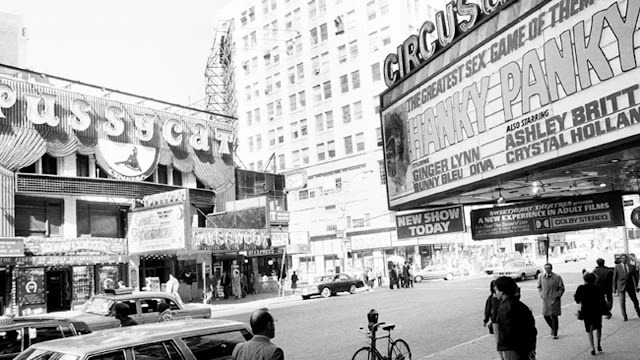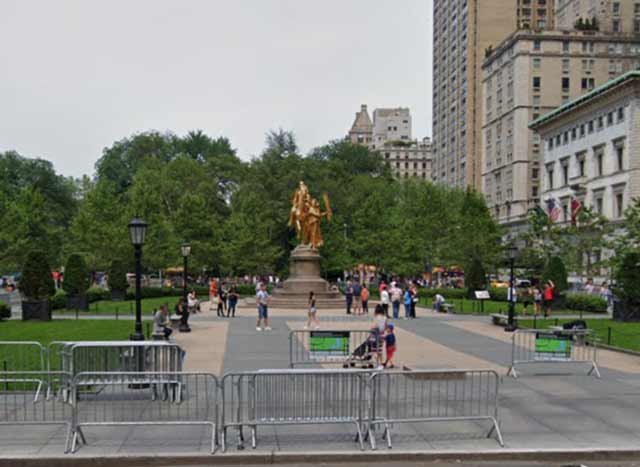Spice on the Fringes of Times Square
 |
| Looking north on Broadway at 49th Street, NYC, during the 1970s. |
Times Square is one of the great tourist attractions in the world. Tourists come from around the world to walk through it and admire the lights and the architecture and the hustle-and-bustle. It may look very similar to the way it used to, but in truth, it has changed dramatically in the last 40 years.
Just looking at the advertisements that appeared in all of the normal newspapers of the day (such as the New York Times, Newsday, you name it) gives you some idea of the types of shows shown at the Big Top. "New! Live! Go-Go Boys!" reads one advertisement. This was all out in the open, with the ads in the theater section near the back of the newspaper. One tag line was "More than just a theatre!" Well, the Big Top served a buffet on Sunday afternoons according to the advertising, so absolutely it was more than just a theater. It was a buffet as well! Yes, those were different times.
"Men Between Themselves" was not a World War II film - I think. Actually, I don't know when it was set, but I have a feeling the setting was likely Fire Island or Key West. But, who knows, those sorts of films literally could be set anywhere and the location wouldn't interfere with the drama.
2023
The Times Square area has been cleaned up quite a bit during the last few decades. "Hustle" had a completely different meaning in the Times Square of the 1970s. During the city's dark days, the adult industry invaded the area in a big way. It wasn't hidden away, either, it was right there out in the open. You've heard of Broadway theaters, well, the Broadway theaters of the 1970s were not just showing "Man of La Mancha" and "Chicago."
The corner of 49th Street and Broadway is right on the fringes of Times Square. It's just a short walk from Madame Tussauds and the Disney store. Great place to bring the family these days.
Well, the area serviced a completely different clientele back in the day.
The corner of 49th Street and Broadway is right on the fringes of Times Square. It's just a short walk from Madame Tussauds and the Disney store. Great place to bring the family these days.
Well, the area serviced a completely different clientele back in the day.
 |
| Note the Big Top entrance just to the right (south) of the main Circus Cinema marquee. |
Located at 1604 Broadway were two theaters that easily could be mistaken for just one. The more obvious theater with the big marquee was Circus Cinema. After opening on March 2, 1971, with "Acts of Love," it showed films for the heterosexual raincoat crowd throughout the 1970s and 1980s. Somewhat obscurely located to its side was a completely different experience, "Big Top Theater." This was entered via a stairway just to the south of the Circus Cinema entrance that led to a separate theater above Circus Cinema. This theater catered to a same-sex clientele. So, the building catered to a broad spectrum of society looking for something a little different than "The Aristocats" and "The Black Stallion" and "Star Wars." Business was good, but eventually, Disney began moving into the area in a big way and nothing has been the same since.
The Big Top was owned by Bill Perry, who also owned the Broadway Baths. He ran "P.M. Productions," a gay film production company, so Perry was sort of the Daryl Zanuck of that particular genre. Rents were high in that area, but Perry was able to pay them due to the steady patronage he was receiving throughout the 1980s until the Big Top finally closed around 1990. I saw a photo afterward showing Big Top as a video store. I'm sure that's long gone, too. Circus Cinema shut down in 1996, a victim of the Giuliani administration's campaign to clean up Times Square and changing times.
 |
| Broadway at 49th Street, NYC, ca. 2020 (Google Street View). |
These days, the raunchy theaters are almost all gone (there may still be one or two over on Eighth Avenue, I'm not entirely sure). The scene above shows how the same corner looks recently. Just to verify that this is the same location, notice the medium-sized brown building in the background of the photo at the top of this page. I've zoomed in on it below just to verify the location.
You may wonder, "Why does this guy focus so much on the sleazier aspects of New York?" Well, overall, I don't, this blog simply is a random overview that focuses on things that have changed. But, you can't understand where we are if you don't know where we came from, even if we sometimes review the outliers of common life. Sleazy theaters (I believe that's an accurate way to describe them, sorry if that offends anyone) were a very common sight in the big tourist areas of Manhattan until very recently, and that certainly has changed, making it prime fodder for this blog. You could not walk through Times Square, perhaps the top tourist destination in the United States, without seeing them all around. If you didn't know that before, you know it now.
 |
| Looking out from the Circus Cinema, October 10, 1984. This is the view that patrons of Big Top would have had when leaving. (AP). |
That's where we were, that's who we were, that's who we are, like it or not. And being ignorant of the past doesn't mean it didn't happen. It just means you choose to ignore or overlook it. That is entirely reasonable but means you will never have the full picture of life in the Big Apple. It's good and bad and wrong and right all coming together in a giant casserole to create the greatest city in the world. Only you can decide what is wrong, what is right, what you find acceptable, and what values and judgments you place on artifacts of the past. I'm just here to give you the information to use as you wish.
One of the themes of this blog is that despite the fact that NYC streets and buildings look the same as in the past, the world around them has changed. It now is a completely different world from just a few decades ago even though in some ways it looks the same. Times change, people change, but in New York City, many of the buildings stay the same. The more things change, the more they stay the same.
I hope you enjoyed this entry in our "the more things change, the more they stay the same" series. Please visit some of our other pages if you liked this one!

























